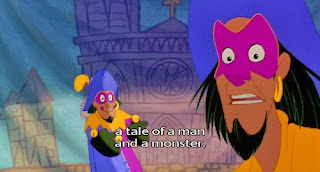At
the beginning of the Disney animated film,
The Hunchback of Notre Dame, Clopin, leader of the gypsies, says one of, if
not the, most significant lines in
the entire movie when he refers to the story of Quasimodo as “the tale of a man and a
monster.”
Initially,
the response is to connect Quasimodo to the so-called “monster” because Clopin
alludes to him in such a mysterious, quite frightening manner. However, by the
end of Hunchback, I realized the
multiple ways in which the line can be taken, and none of them star Quasi in place of the “monster.” I actually felt guilty for being so stereotypical and for taking
the term “monster” so literally, and furthermore, for connecting it to Quasi’s
unsightly appearance. More than guilty, I’m ashamed.
I
may as well have joined the crowd throwing tomatoes during the Festival of
Fools.
In Martin F. Norden’s book chapter
“‘You’re a Surprise from Every Angle’: Disability, Identity, and Otherness in The Hunchback of Notre Dame” he points
out that Quasimodo himself is misled into believing he is a monster “when he
gazes at the beast-like figurine of himself and says very matter-of-factly ‘I
am a monster’ to his stepfather Frollo, who has conditioned him to think of
himself in subhuman terms” (Norden 166). However, our hearts disagree and weep
for Quasi, urging him to gain confidence and realize the beauty within himself.
It pains me to think I could not see this from the very beginning, and that I might
in fact be just like all the other judgmental people in the world.
In one sense, these people are the
monster Clopin referred to. This is one interpretation. The “monster” could be stereotypes
and judgments and cruelty within our massive world that will, it seems, always
exist. This monster tries to tear down Quasimodo, and almost succeeds. The
world itself is the antagonist in Hunchback
for almost the entire length of the film.
At the forefront of this mob stands
Frollo, another viable interpretation of the monster. To put it quite simple, I
want to punch Frollo in the face. He is undoubtedly one of the most terrifying
and truly evil Disney villains, and is far from just a man.
A final understanding of Clopin’s
ambiguous line is that Quasi is himself both a man and a monster, as perceived
by himself and those around him. While his appearance is disfigured, which can
bring people to view him as a beast and a demon, his soul is pure and good. He
is just a (hu)man, like everyone else.
While Norden argues that “the movie
appears to critique the view that ‘different’ people should be kept separate
and isolated, yet it simultaneously perpetuates it” just because Quasimodo does
not end up with Esmeralda in the end, I completely disagree. In watching Hunchback, I realized my own initial
prejudice, which made it a much more real and impactful story for me. If
anything, the film most miraculously shows the need to be welcoming and
accepting of all people.
Except maybe Frollo.




No comments:
Post a Comment